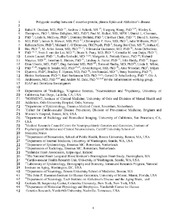Polygenic overlap between C-reactive protein, plasma lipids, and Alzheimer disease
Desikan, Rahul S.; Schork, Andrew J.; Wang, Yunpeng; Thompson, Wesley K.; Dehghan, Abbas; Ridker, Paul M.; Chasman, Daniel I.; McEvoy, Linda K.; Holland, Dominic; Chen, Chi-Hua; Karow, David S.; Brewer, James B.; Hess, Christopher P.; Williams, Julie; Sims, Rebecca; O'Donovan, Michael C.; Choi, Seung Hoan; Bis, Joshua C.; Ikram, M. Arfan; Gudnason, Vilmundur; DeStefano, Anita L.; Van Der Lee, Sven J.; Psaty, Bruce M.; Van Duijn, Cornelia M.; Launer, Lenore; Seshadri, Sudha; Pericak-Vance, Margaret A.; Mayeux, Richard; Haines, Jonathan L.; Farrer, Lindsay A.; Hardy, John; Ulstein, Ingun; Aarsland, Dag; Fladby, Tormod; White, Linda; Sando, Sigrid Botne; Rongve, Arvid; Witoelar, Aree; Djurovic, Srdjan; Hyman, Bradley T.; Snædal, Jon; Steinberg, Stacy; Stefansson, Hreinn; Stefánsson, Kári; Schellenberg, Gerard D.; Andreassen, Ole Andreas; Dale, Anders
Peer reviewed, Journal article
Accepted version

View/
Date
2015-06Metadata
Show full item recordCollections
Original version
https://doi.org/10.1161/circulationaha.115.015489Abstract
Background—Epidemiological findings suggest a relationship between Alzheimer disease (AD), inflammation, and dyslipidemia, although the nature of this relationship is not well understood. We investigated whether this phenotypic association arises from a shared genetic basis. Methods and Results—Using summary statistics (P values and odds ratios) from genome-wide association studies of >200 000 individuals, we investigated overlap in single-nucleotide polymorphisms associated with clinically diagnosed AD and C-reactive protein (CRP), triglycerides, and high- and low-density lipoprotein levels. We found up to 50-fold enrichment of AD single-nucleotide polymorphisms for different levels of association with C-reactive protein, low-density lipoprotein, high-density lipoprotein, and triglyceride single-nucleotide polymorphisms using a false discovery rate threshold <0.05. By conditioning on polymorphisms associated with the 4 phenotypes, we identified 55 loci associated with increased AD risk. We then conducted a meta-analysis of these 55 variants across 4 independent AD cohorts (total: n=29 054 AD cases and 114 824 healthy controls) and discovered 2 genome-wide significant variants on chromosome 4 (rs13113697; closest gene, HS3ST1; odds ratio=1.07; 95% confidence interval=1.05–1.11; P=2.86×10−8) and chromosome 10 (rs7920721; closest gene, ECHDC3; odds ratio=1.07; 95% confidence interval=1.04–1.11; P=3.38×10−8). We also found that gene expression of HS3ST1 and ECHDC3 was altered in AD brains compared with control brains. Conclusions—We demonstrate genetic overlap between AD, C-reactive protein, and plasma lipids. By conditioning on the genetic association with the cardiovascular phenotypes, we identify novel AD susceptibility loci, including 2 genome-wide significant variants conferring increased risk for AD.